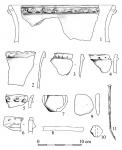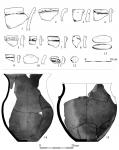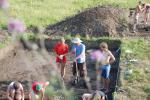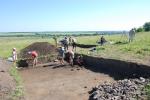Summary (English)
During the season 2010, excavation tranches measured 150 m2 in total were dug out at the SW corner of the hillfort alongside the earthen rampart and the precipice.
The southern excavation site is the only one on the hillfort where cultural debris was detected. It is distinguished by a high amount of burned clay fragments and shreds of pottery. Several vessels were restored from the fragments. They are pots with a rounded body, decorated with a raised border and punctures on the rim. The special find is a bead made of green glass.
Somewhat away from the rampart, where the cultural layer was less thick, a cluster of burned clay that probably remained from a dwelling, was detected on the ancient surface. There were a lot of finds of pottery fragments under it. Especially, broken storage jars with handles look interesting. Besides that, a lot of bone fragments and bone tools were detected in this object. A comb made of the bone plate is the brightest find. Pieces of carved and chopped bones and horns testify that such items were produced directly on the site. Also, a set of spindle whorls and loom sinkers were found here and, some of the pottery fragments had prints of fabric. Metal artefacts from the dwelling are three bronze arrowheads dated by the 7th – 6th c. BC.
A household pit was explored near the dwelling. It is distinguished by the finds of iron pin and big cooking ware, the so-called cauldron-shaped pottery vessels. A cattle skull lay on the bottom of the pit.
Besides that, a pavement made of stone boulders was opened at this excavation site. It was explored on the inner slope of the rampart at a length of 9 m. This pavement covered part of the cultural layer, but it also was covered by cultural debris as well.
Director
- Marcin Ignaczak - Adam Mickiewicz University in Poznan
- Yuriy Boltryk - Institute of Archaeology, National Academy of Sciences of Ukraine
Team
- Oksana Lifantii - National University of Kyiv-Mohyla Academy
- Shelekhan Oleksandr - Institute of Archaeology, National Academy of Sciences of Ukraine
- Łukasz Olędzki - Adam Mickiewicz University in Poznan
Research Body
- Institute of Archaeology, National Academy of Sciences of Ukraine
- Instytut Prahistorii Uniwersytet im. Adama Mickiewicza w Poznaniu
- Національний університет «Києво-Могилянська академія» / National University of Kyiv-Mohyla Academy






![Download [PDF]](/excavation/skins/fasti/images/results/download_sml.png)


